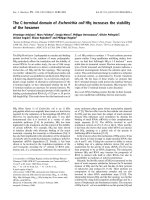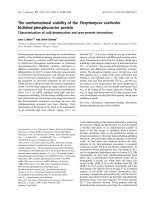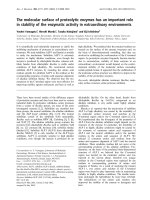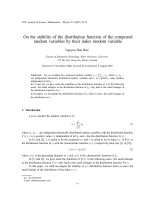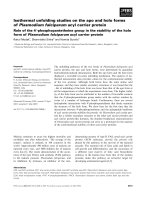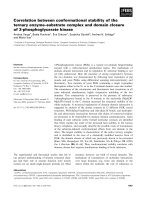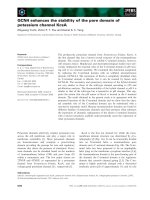HYERS-ULAM STABILITY OF THE LINEAR RECURRENCE WITH CONSTANT COEFFICIENTS DORIAN POPA Received 5 potx
Bạn đang xem bản rút gọn của tài liệu. Xem và tải ngay bản đầy đủ của tài liệu tại đây (478.74 KB, 7 trang )
HYERS-ULAM STABILITY OF THE LINEAR RECURRENCE
WITH CONSTANT COEFFICIENTS
DORIAN POPA
Received 5 November 2004 and in revised form 14 March 2005
Let X be a Banach space over the field R or C, a
1
, ,a
p
∈ C,and(b
n
)
n≥0
asequenceinX.
We investigate the Hyers-Ulam stability of the linear recurrence x
n+p
= a
1
x
n+p−1
+ ···+
a
p−1
x
n+1
+ a
p
x
n
+ b
n
, n ≥ 0, where x
0
,x
1
, ,x
p−1
∈ X.
1. Introduction
In 1940, S. M. Ulam proposed the follow ing problem.
Problem 1.1. Given a metric group (G,
·,d),apositivenumberε, and a mapping f : G →
G which satisfies the inequality d( f (xy), f (x) f (y)) ≤ ε for all x, y ∈ G, do there exist an
automorphism a of G and a constant δ depending only on G such that d(a(x), f (x)) ≤ δ for
all x ∈G?
If the answer to this question is affirmative, we say that the equation a(xy) =a(x)a(y)
is stable. A first answer to this question was given by Hyers [5] in 1941 who proved that the
Cauchy equation is stable in Banach spaces. This result represents the starting point the-
ory of Hyers-Ulam stability of functional equations. Generally, we say that a functional
equation is stable in Hyers-Ulam sense if for every solution of the perturbed equation,
there exists a solution of the equation that di ffers from the solution of the perturbed
equation with a small error. In the last 30 years, the stability theory of functional equa-
tions was strongly developed. Recall that very important contributions to this subject
were brought by Forti [2], G
˘
avrut¸a [3], Ger [4], P
´
ales [6, 7], Sz
´
ekelyhidi [9], Rassias [8],
and Trif [10]. As it is mentioned in [1], there are much less results on stability for func-
tional equations in a single variable than in more variables, and no surveys on this subject.
In our paper, we will investigate the discrete case for equations in single variable, namely,
the Hyers-Ulam stability of linear recur rence with constant coefficients.
Let X beaBanachspaceoverafieldK and
x
n+p
= f
x
n+p−1
, ,x
n
, n ≥ 0, (1.1)
arecurrenceinX,whenp is a positive integer, f : X
p
→ X is a mapping, and x
0
,x
1
, ,x
p−1
∈ X. We say that the recurrence (1.1) is stable in Hyers-Ulam sense if for every positive ε
Copyright © 2005 Hindawi Publishing Corporation
Advances in Difference Equations 2005:2 (2005) 101–107
DOI: 10.1155/ADE.2005.101
102 Hyers-Ulam stability of a linear recurrence
and every sequence (x
n
)
n≥0
that satisfies the inequality
x
n+p
− f
x
n+p−1
, ,x
n
<ε, n ≥0, (1.2)
there exist a sequence (y
n
)
n≥0
given by the recurrence (1.1) and a positive δ depending
only on f such that
x
n
− y
n
<δ, n ≥0. (1.3)
In [7], the author investigates the Hyers-Ulam-Rassias stability of the first-order linear
recurrence in a Banach space. Using some ideas from [7] in this paper, one obtains a
result concerning the stability of the n-order linear recurrence with constant coefficients
in a Banach space, namely,
x
n+p
= a
1
x
n+p−1
+ ···+ a
p−1
x
n+1
a +a
p
x
n
+ b
n
, n ≥ 0, (1.4)
where a
1
,a
2
, ,a
p
∈ K,(b
n
)
n≥0
is a given sequence in X,andx
0
,x
1
, ,x
p−1
∈ X.Many
new and interesting results concerning difference equations can be found in [1].
2. Main results
In what follows, we denote by K the field C of complex numbers or the field R of real
numbers. Our stability result is based on the following lemma.
Lemma 2.1. Let X be a Banach space over K, ε apositivenumber,a ∈ K \{−1,0,1},and
(a
n
)
n≥0
asequenceinX.Supposethat(x
n
)
n≥0
is a sequence in X with the following property:
x
n+1
−ax
n
−a
n
≤ ε, n ≥ 0. (2.1)
Then there exists a sequence (y
n
)
n≥0
in X satisfying the relations
y
n+1
= ay
n
+ a
n
, n ≥ 0, (2.2)
x
n
− y
n
≤
ε
|a|−1
, n ≥ 0. (2.3)
Proof. Denote x
n+1
−ax
n
−a
n
:= b
n
, n ≥ 0. By induction, one obtains
x
n
= a
n
x
0
+
n−1
k=0
a
n−k−1
a
k
+ b
k
, n ≥ 1. (2.4)
(1) Suppose that |a|< 1. Define the sequence (y
n
)
n≥0
by the relation (2.2)withy
0
=x
0
.
Then it follows by induction that
y
n
= a
n
x
0
+
n−1
k=0
a
n−k−1
b
k
, n ≥ 1. (2.5)
Dorian Popa 103
Bytherelation(2.4)and(2.5), one gets
x
n
− y
n
≤
n−1
k=0
b
k
a
n−k−1
≤
n−1
k=0
b
k
|a|
n−k−1
≤ ε
1 −|a|
n
1 −|a|
<
ε
1 −|a|
, n ≥ 1.
(2.6)
(2) If |a|> 1, by using the comparison test, it follows that the series
∞
n=1
(b
n−1
/a
n
)is
absolutely convergent, since
b
n−1
a
n
≤
ε
|a|
n
, n ≥ 1,
∞
n=1
ε
|a|
n
=
ε
|a|−1
.
(2.7)
Denoting
s :=
∞
n=1
b
n−1
a
n
, (2.8)
we define the sequence (y
n
)
n≥0
bytherelation(2.2)withy
0
= x
0
+ s.
Then one obtains
x
n
− y
n
−a
n
s +
n−1
k=0
b
k
a
n−k−1
=|a|
n
−s+
n−1
k=0
b
k
a
k+1
=|
a|
n
∞
k=n
b
k
a
k+1
≤ ε
∞
n=1
1
|a|
n
=
ε
|a|−1
, n ≥ 0.
(2.9)
The lemma is proved.
Remark 2.2. (1) If |a| > 1, then the sequence (y
n
)
n≥0
from Lemma 2.1 is uniquely deter-
mined.
(2) If |a| < 1, then there exists an infinite number of sequences (y
n
)
n≥0
in Lemma 2.1
that satisfy (2.2)and(2.3).
Proof. (1) Suppose that there exists another sequence (y
n
)
n≥0
defined by (2.2), y
0
=x
0
+ s,
that satisfies (2.3). Hence,
x
n
− y
n
a
n
x
0
− y
0
+
n−1
k=0
b
k
a
n−k−1
=|
a|
n
x
0
− y
0
+
n−1
k=0
b
k
a
k+1
, n ≥ 1. (2.10)
Since
lim
n→∞
x
0
− y
0
+
n−1
k=0
b
k
a
k+1
=
x
0
+ s− y
0
=0, (2.11)
104 Hyers-Ulam stability of a linear recurrence
it follows that
lim
n→∞
x
n
− y
n
=∞. (2.12)
(2) If |a| < 1, one can choose y
0
= x
0
+ u, u≤ε.Then
x
n
− y
n
=
−
a
n
u +
n−1
k=0
b
k
a
n−k−1
≤ ε
n
k=0
|a|
k
= ε
1 −|a|
n+1
1 −|a|
≤
ε
1 −|a|
, n ≥ 1.
(2.13)
The stability result for the p-order linear recurrence with constant coefficients is con-
tained in the next theorem.
Theorem 2.3. Let X beaBanachspaceoverthefieldK, ε>0,anda
1
,a
2
, ,a
p
∈ K such
that the equation
r
p
−a
1
r
p−1
−···−a
p−1
r −a
p
= 0 (2.14)
admits the roots r
1
,r
2
, ,r
p
, |r
k
| = 1, 1 ≤ k ≤ p,and(b
n
)
n≥0
isasequenceinX.Suppose
that (x
n
)
n≥0
is a sequence in X with the property
x
n+p
−a
1
x
n+p−1
−···−a
p−1
x
n+1
−a
p
x
n
−b
n
≤ ε, n ≥ 0. (2.15)
Then there exists a sequence (y
n
)
n≥0
in X given by the recurrence
y
n+p
= a
1
y
n+p−1
+ ···+ a
p−1
y
n+1
+ a
p
y
n
+ b
n
, n ≥ 0, (2.16)
such that
x
n
− y
n
≤
ε
r
1
−1
···
r
p
−1
, n ≥ 0. (2.17)
Proof. We prove Theorem 2.3 by induction on p.
For p = 1, the conclusion of Theorem 2.3 is true in virtue of Lemma 2.1.Supposenow
that Theorem 2.3 holds for a fixed p ≥ 1. We have to prove the following assertion.
Assertion 2.4. Let ε be a positive number and a
1
,a
2
, ,a
p+1
∈ K such that the equation
r
p+1
−a
1
r
p
−···−a
p
r −a
p+1
= 0 (2.18)
admits the roots r
1
,r
2
, ,r
p+1
, |r
k
| = 1, 1 ≤ k ≤ p +1,and(b
n
)
n≥0
is a sequence in X.If
(x
n
)
n≥0
is a sequence in X satisfying the relation
x
n+p+1
−a
1
x
n+p
−···−a
p
x
n+1
−a
p+1
x
n
−b
n
≤ ε, n ≥ 0, (2.19)
then there exists a sequence (y
n
)
n≥0
in X,givenbytherecurrence
y
n+p+1
= a
1
y
n+p
+ ···+ a
p
y
n+1
+ a
p+1
y
n
+ b
n
, n ≥ 0, (2.20)
Dorian Popa 105
such that
x
n
− y
n
≤
ε
r
1
−1
···
r
p+1
−1
, n ≥ 0. (2.21)
Therelation(2.19) can be written in the form
x
n+p+1
−
r
1
+ ···+ r
p+1
x
n+p
−···+(−1)
p+1
r
1
···r
p+1
x
n
−b
n
≤ ε, n ≥ 0. (2.22)
Denoting x
n+1
−r
p+1
x
n
= u
n
, n ≥ 0, one gets by (2.22)
u
n+p
−
r
1
+ ···+ r
p
u
n+p−1
+ ···+(−1)
p
r
1
r
2
···r
p
u
n
−b
n
≤ε, n ≥ 0. (2.23)
By using the induction hypothesis, it follows that there exists a sequence (z
n
)
n≥0
in X,
satisfying the relations
z
n+p
= a
1
z
n+p−1
+ ···+ a
p
z
n
+ b
n
, n ≥ 0, (2.24)
u
n
−z
n
≤
ε
r
1
−1
···
r
p
−1
, n ≥ 0. (2.25)
Hence
x
n+1
−r
p+1
x
n
−z
n
≤
ε
r
1
−1
···
r
p
−1
, n ≥ 0, (2.26)
and taking account of Lemma 2.1,itfollowsfrom(2.26) that there exists a sequence
(y
n
)
n≥0
in X, given by the recurrence
y
n+1
= r
p+1
y
n
+ z
n
, n ≥ 0, (2.27)
that satisfies the relation
x
n
− y
n
≤
ε
r
1
−1
···
r
p+1
−1
, n ≥ 0. (2.28)
By (2.24)and(2.27), one gets
y
n+p+1
= a
1
y
n+p
+ ···+ a
p+1
y
n
+ b
n
, n ≥ 0. (2.29)
The theorem is proved.
Remark 2.5. If |r
k
| > 1, 1 ≤k ≤ p,inTheorem 2.3, then the sequence (y
n
)
n≥0
is uniquely
determined.
Proof. The proof follows from Remark 2.2.
Remark 2.6. If there exists an integer s,1≤ s ≤ p,suchthat|r
s
|=1, then the conclusion
of Theorem 2.3 is not generally true.
106 Hyers-Ulam stability of a linear recurrence
Proof. Let ε>0, and consider the sequence (x
n
)
n≥0
, given by the recurrence
x
n+2
+ x
n+1
−2x
n
= ε, n ≥ 0, x
0
,x
1
∈ K. (2.30)
A particular solution of this recurrence is
x
n
=
ε
3
n, n ≥ 0, (2.31)
hence the general solution of the recurrence is
x
n
= α + β(−2)
n
+
ε
3
n, n ≥ 0, α, β ∈K. (2.32)
Let (y
n
)
n≥0
be a sequence satisfying the recurrence
y
n+2
+ y
n+1
−2y
n
= 0, n ≥0, y
0
, y
1
∈ K. (2.33)
Then y
n
= γ + δ(−2)
n
, n ≥ 0, γ,δ ∈ K,and
sup
n∈N
x
n
− y
n
=∞
. (2.34)
Example 2.7. Let X be a Banach space and ε apositivenumber.Supposethat(x
n
)
n≥0
is a
sequence in X satisfying the inequality
x
n+2
−x
n+1
−x
n
≤ ε, n ≥ 0. (2.35)
Then there exists a sequence ( f
n
)
n≥0
in X given by the recurrence
f
n+2
− f
n+1
− f
n
= 0, n ≥0, (2.36)
such that
x
n
− f
n
≤ (2 +
√
5)ε, n ≥0. (2.37)
Proof. The equation r
2
−r −1 = 0 has the roots r
1
= (1 +
√
5)/2, r
2
= (1 −
√
5)/2. By the
Theorem 2.3, it follows that there exists a sequence ( f
n
)
n≥0
in X such that
x
n
− f
n
≤
ε
r
1
−1
r
2
−1
=
(2 +
√
5)ε, n ≥0. (2.38)
References
[1] R. P. Agarwal, Difference Equations and Inequalities. Theory, Methods, and Applications,Mono-
graphs and Textbooks in Pure and Applied Mathematics, vol. 228, Marcel Dekker, New
York, 2000.
[2] G. L. Forti, Hyers-Ulam stability of functional equations in several variables, Aequationes Math.
50 (1995), no. 1-2, 143–190.
[3] P. G
˘
avrut¸a, A generalization of the Hyers-Ulam-Rassias stability of approximately additive map-
pings, J. Math. Anal. Appl. 184 (1994), no. 3, 431–436.
Dorian Popa 107
[4] R. Ger, A survey of recent results on stability of functional equat ions,Proc.ofthe4thInter-
national Conference on Functional Equations and Inequalities (Cracow), Pedagogical Uni-
versity of Cracow, Poland, 1994, pp. 5–36.
[5] D. H. Hyers, On the stability of the linear functional equation,Proc.Nat.Acad.Sci.USA27
(1941), 222–224.
[6] Z. P
´
ales, Generalized stabilit y of the Cauchy functional equation, Aequationes Math. 56 (1998),
no. 3, 222–232.
[7]
, Hyers-Ulam stability of the Cauchy functional equation on square-symmetric groupoids,
Publ. Math. Debrecen 58 (2001), no. 4, 651–666.
[8] Th. M. Rassias, On the stability of the linear mapping in Banach spaces,Proc.Amer.Math.Soc.
72 (1978), no. 2, 297–300.
[9] L. Sz
´
ekelyhidi, Note on Hyers’s theorem,C.R.Math.Rep.Acad.Sci.Canada8 (1986), no. 2,
127–129.
[10] T. Trif, On the stability of a general gamma-type functional equation,Publ.Math.Debrecen60
(2002), no. 1-2, 47–61.
Dorian Popa: Department of Mathematics, Faculty of Automation and Computer Science, Tech-
nical University of Cluj-Napoca, 25-38 Gh. Baritiu Street, 3400 Cluj-Napoca, Romania
E-mail address:

